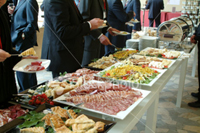Organize Your Meeting
Multi-Site meetings held through video conferencing, satellite broadcasting, or web-based collaboration, offer an opportunity for a message to be communicated to large and geographically diverse groups simultaneously.
To realize the powerful impact that large Multi-Site meetings can offer, the content of the meeting must focus on very select, large and powerful messages. The meeting should be built upon a consistent theme and it should follow a set timeline. Below, we note in greater detail some key items to consider.
Style/Theme

High quality events that deliver a lasting impression start with a theme and impact in mind and build from there.
A theme for the entire event should be singular and carry through all aspects of planning. Consideration should be given to theme of an event from approximately 2 hours prior to the start of the event through 1 hour afterwards. Planning with this timeframe in mind will include details such as available parking (if needed), beverage service, an event theme logo, the manner in which to invite participants, staging, food service, memorabilia (gifts), entertainment, executive appearances and more.
The theme of an event starts before the meeting begins and ends with the lasting impression left with each attendee. With this in mind, a theme becomes paramount in planning an event.
Timeline
While many key events are unscripted and by their nature are short notice, where possible, event planners should allow 60 days to plan a major, multi-site event. Consideration should be given to the time of year and regional observations of special events such as national, state or provincial holidays.
The date, day of the week and especially the time of day should also be considered. This is especially true if meeting locations span many time zones. A particularly important consideration for terrestrial communications is the time of local peak call demand (or IP session demand) and its impact on available bandwidth at each location. Lack of bandwidth is certain to cause problems either for meeting attendees or others within a given meeting location.
 We commit ourselves to the success of your meeting and to the systems that carry your message across the country or around the world.
We commit ourselves to the success of your meeting and to the systems that carry your message across the country or around the world. - Mark Balgeman, Communications Specialist
- Mark Balgeman, Communications Specialist
Production
Special consideration should be given to how the event begins. An opening video, for example, produced especially for the meeting will set the theme in motion. If a speaker starts the meeting, it is his/her job to set the expectations of and tempo for the meeting.
Event tempo is the pace at which the announcement of information progresses. It communicates the significance of the event about which the meeting is focusing on the basis of the type of emotional involvement desired from the audience.
For example when a message is delivered slowly and methodically, it evokes an emotion of safety, honesty and wisdom. This is ideal for the announcement of the merger of two firms. Conversely, when a message is delivered quickly and with enthusiasm, it evokes excitement and interest. This is ideal for a product launch.
What is the ideal speed at which to deliver the message? Some examples follow:
- Merger of two firms (slow tempo, shows deliberate planning and good judgment)
- Annual Meeting (mid-range tempo, shows progress that is well managed)
- Product launch (fast tempo, generates enthusiasm for a first-in-class product)
Production of the Event
Production of the event should be closely integrated to support the event theme. If multiple venues are used with a question and answer session ("Q&A"), it is essential to designate proctors for Q&A at each location. This person is knowledgeable about the timeline, theme and tempo of the meeting. The proctors should be well informed about the content of the event message so they can provide continuity within their meeting location. Continuity is an important consideration when a meeting includes breaks or meals. Executives as proctors can enhance the importance of the message at each location.
Conclusion
Planning for a Multi-Site meeting is critical in order to achieve the desired impact and result. Meetings that span many regions must take into account regional variations which may include special holidays and possible network congestion among other items. Further, regional perspectives may be influenced by factors that are outside the planning process for the meeting such local customs and protocols. All of these items affect the impact of the message. Highly focused messages can be effectively communicated if they are well crafted and delivered with the understanding of each participant's regional influences.
Highly focused messages can be effectively communicated if they are well crafted and delivered with the understanding of each participant's regional influences.
About TKO Video Communications
As a high-quality video communications solution provider, TKO provides video conferencing equipment, software, outsourcing and event management including satellite broadcasting, video and audio streaming and audio conferencing services.


